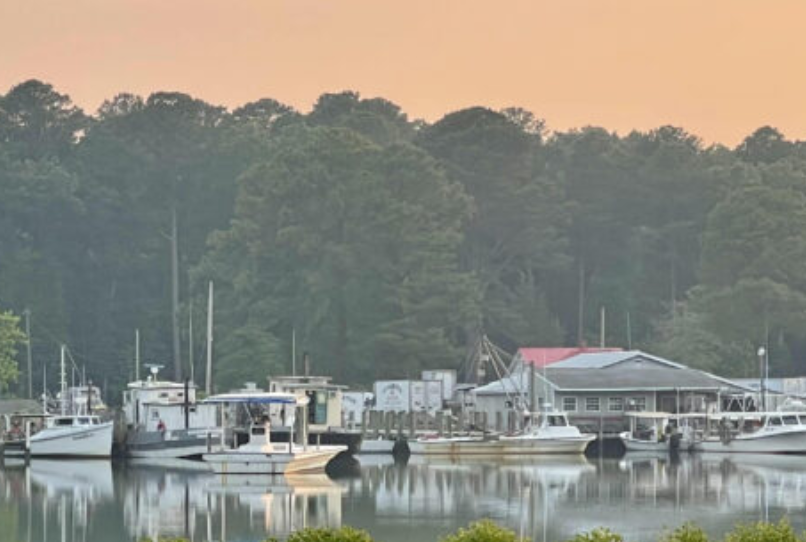
A distinctive smoky haze lingered over the crabbing fleet all day Thursday at PT Hambleton’s facility on Grace Creek in Bozman. Dennis Forney Photo
The white-coated man behind the seafood case in the grocery store sees me eyeing the round, plastic containers of crab meat set in ice. Traditional one-pound containers.
“Can I help you?”
I squint my eyes a little, making sure I’m reading the prices correctly, my mind running through numbers like an old-fashioned cash register. Jumbo lump crab meat, $63. Regular lump crab meat, $43.
“The crab meat,” I say. “Those prices look high.”
His answer comes quickly. “Not as high as Annapolis. A pound of jumbo lump over there is running about $75.”
There’s no claw meat as there has been sometimes in the past. No special either.
“That lump meat is now what they call special.”
I thank the man for the information, tilt my hat back, scratch my head a little. Not sure how that helps the thinking process but maybe it does. Then I turn, walk away, and head for the cashier to pay for the four-gallon plastic trash bags I’ll put in the plastic paint bucket I bought at the hardware store to put beside my sink for food waste. Keeps it out of the sink and the disposal and the septic system and the waters where the crabs grow. They have enough to eat without me adding more nutrients to the system.
Looking at the crab meat prices was more of a fact-finding mission than a dinner decision.
Inflation and high prices are on everyone’s mind. Soft crabs have been scarce lately. I saw some in another seafood case the other day – they were good-sized soft crabs, alive – $7.75 each. More sticker shock.
“Market’s terrible,” a local buyer tells me. “”Used to be crabs were something people ate as a regular part of their diet. Not anymore. Look at the prices. Now they’re a delicacy, a luxury item. Soft crabs are scarce because peelers are scarce. A Delaware Bay crabber said there hasn’t been hardly any peeler run so far this year. But there’s lots of little crabs out there.”
Another chimes in. “This is never usually a strong time for the market.”
And another: “Ocean City was strong over Memorial Day weekend but not what it’s been in the past.”
Prices. Not just for crabs, for all kinds of food items.
Conversation shifts. “Did you smell the smoke in the air this morning and see the haze? It’s the wild fires up in Canada, Nova Scotia. They say half the island’s on fire.”
I did smell the smoke Thursday morning and noticed the haze that softened the edges of the clouds and the trees in the distance. Smelling smoke in the morning strikes me as unusual.
National Weather Service says the smoky smell and haze are a result of the Canadian fires up north, fires scorching parts of New Jersey’s Pione Barrens and fires out west. They expect those conditions, coming at us from sources thousands of miles away, to persist for a while.
More head scratching, wondering, my mind scrolling and scanning, trying to make sense of it all, trying to connect all of the dots. Plastic containers, plastic bags, plastic paint pails. Plastics all made from fossil fuels. The burning of fossil fuels, we’re told, part of the equation leading to a warming of the climate, changes in weather patterns, “smoke on the water and fire in the sky.” Everything contributes.
Back to crabs. Watermen are getting $150 per bushel at the moment, fairly typical for this time of the year. The winter dredge survey, results announced recently, showed significantly higher numbers of crabs in the Chesapeake compared to 2022.
“Lots of little crabs out there now. Lots of them.”
Prices should moderate as the season progresses into the summer. Demand will be higher but so too will be supply. And as the sheds continue with each full moon, crabs are getting bigger too.
“By late summer and fall, there will be plenty of crabs.”
Anecdotal reporting, that’s what I do. Listening and observing, bits and snatches of information coming from all different directions – just as irregular and numerous as jigsaw puzzle pieces – helping form our ever-changing world view, completing a puzzle that’s really never completed..
If you made it with me this far, thanks for reading.




Deirdre LaMotte says
A few years ago in Maine they could not give lobsters away, they were so cheap. Why is it the price of crabs always remains high??
Even in seasons where they are plentiful.
Paul Rybon says
Hi Ddirdre, The watermen tell anyone who will listen that the cost of crabbing in Maryland is very high. Fuel is high. Bait is high because fuel is high. Fees, permits, licenses, surcharges continue to rise. Limits, quotas, and restrictions from the State hamper the amount of crabs that can be caught. Buyers costs drive them to raise prices in order to make a profit. I have come to relish blue catfish because they are free to catch any bait will work, and they taste pretty good. And they are everywhere
Francine De Sanctis says
Thank you for answering questions I’ve wondered about, especially the burning smell.
I guess we’ll wait until Fall to enjoy crabs this year?